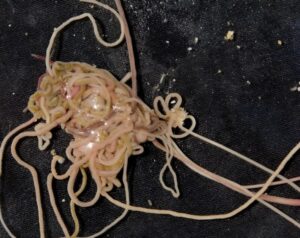For years, I had grown used to the ordinary mess that comes with living with cats — fur clinging to every blanket, stray pawprints on windowsills, even the occasional clump of dirt tracked in from the balcony or garden. So when I noticed something unusual on my bed one evening, my first thought was simple: Oh, it must just be dirt the cats dragged inside.
But within minutes, that casual assumption turned into the most horrifying discovery I had ever made.

What caught my eye wasn’t just fur or dust. Mixed in with the shed hairs were tiny, round, yellowish beads — so small they could easily be mistaken for grains of sand. At first, I dismissed them, thinking perhaps the cats had been digging near a plant pot or walked across the windowsill again. But the texture was off. These little pellets were too firm, too smooth, too uniform. They didn’t crumble like sand or soil. Something about them felt wrong.
The more I looked, the more unsettled I became. Curiosity quickly gave way to dread. I snapped a photo, opened my laptop, and began searching. Within a few clicks, my heart began to pound.
Every source I found said the same thing: these weren’t bits of dirt at all. They were tapeworm eggs.
My stomach lurched. Tapeworms are parasites — dangerous not just for animals but for humans too. Reading the words on the screen, I felt as if the air had been sucked out of the room. My hands shook as I tried to process what this meant.
What horrified me most was realizing that my cats, though mostly indoor pets, could still be exposed. I sometimes take them out on leashes for fresh air, and in doing so, they may have brushed against contaminated soil, grass, or even sidewalks. Worm eggs can be practically anywhere: hidden in the dirt, carried on insects, or even stuck to the bottom of people’s shoes.
There was no time to waste. I gathered the cats and rushed to the veterinary clinic, my mind racing the entire way.
At the vet, my worst fear was confirmed. Tests revealed that one of my cats had indeed been infected with dipylidiosis — an illness caused by the cucumber tapeworm (Dipylidium caninum). The veterinarian explained that these parasites often look like thin, white strands resembling spaghetti, and their eggs appear either as tiny grains of rice or as small dried balls, exactly like the ones I had discovered on my bed.
Hearing the confirmation felt like a punch to the chest.
While the cats were immediately started on treatment, another thought gnawed at me: What about me?

The doctor explained that humans can also contract tapeworms — often without realizing it. Infection can happen by accidentally ingesting the eggs, something disturbingly easy to do. Simple, everyday interactions like kissing your pet’s head, letting them lick your hands, or forgetting to wash properly after touching them could be enough to cause transmission.
I couldn’t take the risk. The very same day, I went to a clinic to get myself tested. The wait for results was nerve-racking, every hour filled with the fear that I might already be carrying the same parasite.
Thankfully, my results came back clear. No infection. Relief washed over me, though the experience left me shaken to the core.
Once back home, I didn’t waste a second. I launched into full-scale disinfection mode. I scrubbed and mopped every floor with antiseptic solution, laundered every bedsheet, blanket, and pillowcase at the highest temperature, vacuumed and sanitized the carpets, sprayed down furniture, and even cleaned soft toys and cushions that might have come into contact with the cats.
The ordeal was exhausting but necessary. I couldn’t let even the smallest chance of reinfection linger in my home.
Looking back, the entire experience has changed the way I care for my pets and my household. My cats mean everything to me, and I’ll always love them. But I now understand that love must come hand in hand with vigilance. Parasites like tapeworms are invisible threats, often dismissed until it’s too late.
If you ever find strange little particles, especially ones that resemble grains of rice or tiny hard balls, mixed in with your pet’s fur or scattered on your furniture, please don’t ignore it. What looks harmless could be a sign of something very dangerous.

I share my story as both a warning and a reminder: being a responsible pet owner isn’t just about cuddles, food, and play. It’s about protecting your pets’ health, your own health, and your home.
In the end, what I found on my bed that day may have terrified me, but it also saved us. Without it, I might never have known the truth until it was too late.


